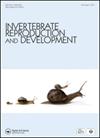布氏斑蝽生活史和形态的季节变化(半翅目:斑蝽科)
IF 0.8
4区 生物学
Q4 REPRODUCTIVE BIOLOGY
引用次数: 0
摘要
昆虫物候和形态的温度依赖性研究有助于研究温度对其生长、发育和种群动态的影响。在实验室条件下,采用湿季和旱季两种饲养方式,研究了季节变化对布氏异色瓢虫生命周期和形态的影响。暖温(湿季)条件下,虫卵的平均孵化期、1 ~ 5龄幼虫的发育时间和总发育时间均显著小于冷温(旱季)条件下。然而,在温暖的温度下,孵化率显著高于寒冷的温度。若虫和成虫在温暖温度下的形态测量值也明显低于寒冷温度。在温暖的潮湿季节,实验室饲养的个体比旱季发育更快,个体体积更小。实验个体的发育时间和体型与饲养温度呈显著负相关。研究进一步表明,在温暖的温度下,实验个体的发育时间变短,从而可能增加这种昆虫的世代数。本文章由计算机程序翻译,如有差异,请以英文原文为准。
Seasonal variations in the life cycle and morphology of Anisops breddini (Hemiptera: Notonectidae)
ABSTRACT Studies on temperature-dependent phenology and morphology of insects facilitate examination of the consequences of temperature on their growth, development and population dynamics. The effects of seasonal changes on the life cycle and morphometry of Anisops breddini were studied by rearing eggs to adults under laboratory conditions during the wet and dry seasons. The average incubation period of eggs, developmental durations of instars I–V and total developmental time were significantly less at warm temperature (wet season) than in cold temperature (dry season). However, the hatching percentage was significantly higher at warm temperature than in cold temperature. Morphometric measurements of nymphs and adults were also significantly less at warm temperature than in cold temperature. Laboratory reared individuals during the wet season at warm temperature had faster development and produced smaller individuals as compared with the dry season. The developmental durations and body size of the experimental individuals were significantly negatively correlated with rearing temperature. The study further revealed that in warm temperature the developmental duration of the experimental individuals become shorter which in turn might increase the number of generations of this insect.
求助全文
通过发布文献求助,成功后即可免费获取论文全文。
去求助
来源期刊
CiteScore
1.90
自引率
0.00%
发文量
21
审稿时长
>12 weeks
期刊介绍:
Invertebrate Reproduction & Development ( IRD) presents original research on the reproductive and developmental biology of the Invertebrata, both embryonic and postembryonic. IRD welcomes papers reporting significant results obtained using new techniques. Encouraged topic areas include: aquaculture, physiology, biochemistry, functional morphology, phylogeny, behavioural and regulatory mechanisms, including genetic, endocrine and molecular studies. Papers containing qualitative descriptions of reproductive cycles and gametogenesis will not be considered. IRD is published in association with the International Society of Invertebrate Reproduction and Development.

 求助内容:
求助内容: 应助结果提醒方式:
应助结果提醒方式:


